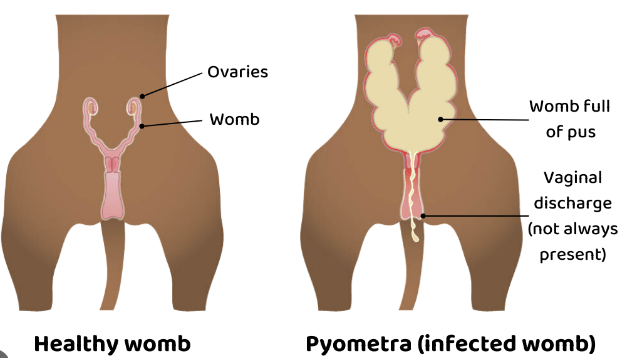What is a Pyometra?
Pyometra is a serious bacterial infection of the uterus that can become life threatening to your beloved cat or dog. Pyometra is most common in older females that are not desexed. Whilst there is no known cause to the Pyometra, it is known that is often occurs in middle aged females after they have had multiple heats and more commonly have not had any puppies. It often occurs after the animal has finished their heat cycle as the lining thickens allowing an optimal environment for the bacteria to grow.
What are the signs?
One of the first signs of Pyometra is that your animal may begin to feel very unwell, more often than not they will have a poor appetite, may be drinking a lot of water and urinating more frequently. As the Pyometra begins to progress further your animal will become more noticeably ill, having a bloated stomach, pussy discharge from their vagina and vomiting. More severe signs are fever, distended belly’s and for the animal to collapse.
· Increased thirst and urination
· Fever
· Pussy discharge
· Loss of appetite
· Vomiting
· Distended bellies and bloating
· Weakness or collapse
** IT IS VERY IMPORTANT TO NOTE THEY MAY NOT HAVE ANY DISCHAGRE**
There are two types of Pyometra, the first being where your animal’s cervix is open, this is when it is a lot easier to tell if your animal is suffering a Pyometra as the pussy discharge is noticeable. The second type of Pyometra is a closed cervix, this version of the Pyometra is life-threatening as there is nowhere for the pussy discharge to drain. This it puts your pet at risk of their uterus rupturing, which can be fatal for your dog or cat.
How can it be treated?
There are two different ways in which a Pyometra can be treated the first being medically. This is the lesser chosen treatment option out of the two as the infection still has a high possibility of returning. Medical treatment of Pyometra works best with dogs suffering from open cervix Pyometra as the puss needs to be able to drain and flush out of the system, however even if that is the case it is mostly only done with high quality breeding dogs as the risks associated with the infection returning are extremely high. Medical treatment consists of copious amount of antibiotics, hormone treatment, intravenous fluids and pain relief in order to attempt to flush the infection out of the body.
The second treatment option is to spay the animal, this involves removing the entire uterus. Spaying the animal is the most effective treatment for a Pyometra, both closed and open as it removes the source of infection. Even though the source is removed the animal will still need to go on fluids, antibiotics and pain relief to remove any lingering infection.
How can it be prevented?
The best form of prevention for Pyometra is to spay the animal at an appropriate age. If the dog is intended to be bred it should be done at an appropriate age depending on the breed of the dog to minimize their risk of developing a Pyometra. Desexing your dog or cat younger is safer and less costly than risking a Pyometra occurring.
Who do I call?
